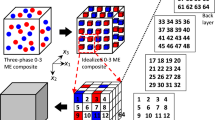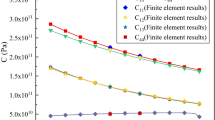Abstract
The overall time-dependent and nonlinear responses of two-phase magnetostrictive polymer composites are obtained by coupling micromechanical analysis for magnetoelastic coupled composites with a time-integration algorithm for thermorheologically complex materials. The nonlinear magnetoelastic behavior is due to large magnetic driving fields while the nonlinear viscoelastic response is associated with stress and temperature. Because of the material nonlinearity of these constituents, linearized constitutive relations are first defined for obtaining the trial overall responses of the magnetostrictive composites followed by an iterative scheme in order to correct errors from linearizing the nonlinear responses. The presented micromechanical formulation is applicable to magnetostrictive composites reinforced by continuous fiber, particle, and lamina reinforcements. The predicted responses of the composites are first validated with the experimental data available in the literature. Numerical results are then presented for the magnetostrictive composites with 1–3, 0–3, and 2–2 connectivity in terms of their strain and magnetic flux density responses. Time-dependent and nonlinear behaviors show the different degrees of the dependency on microstructural geometry, reinforcement volume fraction, environmental temperature, and loading rate of magnetic and mechanical inputs.












Similar content being viewed by others
References
Aboudi, J.: Mechanics of Composite Materials: a Unified Micromechanical Approach. Elsevier, Amsterdam (1991)
Aboudi, J., Arnold, S.M., Bednarcyk, B.A.: Micromechanics of Composite Materials: a Generalized Multiscale Analysis Approach. Butterworth-Heinemann, Oxford (2013)
Aboudi, J., Zheng, X., Jin, K.: Micromechanics of magnetostrictive composites. Int. J. Eng. Sci. 81, 82–99 (2014)
Anjanappa, M., Wu, Y.: Magnetostrictive particulate actuators: configuration, modeling and characterization. Smart Mater. Struct. 6, 393–402 (1997)
Carman, G., Mitrovic, M.: Nonlinear constitutive relations for magnetostrictive materials with applications to 1-D problems. J. Intel. Mat. Syst. Str. 6(5), 673–683 (1995)
Deng, Z., Dapino, M.J.: Review of magnetostrictive materials for structural vibration control. Smart Mater. Struct. 27, 113001 (2018)
Elhajjar, R.F., Law, C.T.: Magnetomechanical local-global effects in magnetostrictive composite materials. Model. Simul. Mater. Sci. Eng. 23, 075002 (2015)
Elhajjar, R., Law, C., Pegoretti, A.: Magnetostrictive polymer composites: recent advances in materials, structures and properties. Prog. Mater Sci. 97, 204–229 (2018)
Engdahl, G.: Handbook of Giant Magnetostrictive Materials. Academic Press, London (2000)
Espinosa-Almeyda, Y., Camacho-Montes, H., Nava-Gómez, G.G., Madrazo, B.J.M., Guinovart-Díaz, R., López-Realpozo, J.C.: The influence of galfenol constituent in the improvement of the magnetoelectric coupling effect for composite materials. Math. Method Appl. Sci. 40(9), 3320–3332 (2017)
Fan, Y., Gomez, A., Ferraro, S., Pinto, B., Muliana, A., Saponara, V.L.: Diffusion of water in glass fiber reinforced polymer composites at different temperatures. J. Compos. Mater. 53(8), 1097–1110 (2019)
Ferry, J.D.: Viscoelastic Properties of Polymers, 3rd edn. Wiley, NewYork (1980)
Guan, X., Dong, X., Ou, J.: Predicting performance of polymer-bonded Terfenol-D composites under different magnetic fields. J. Magn. Magn. Mater. 321(18), 2742–2748 (2009)
Haj-Ali, R.M., Muliana, A.: A multi-scale constitutive formulation for the nonlinear viscoelastic analysis of laminated composite materials and structures. Int. J. Solids Struct. 41(13), 3461–3490 (2004)
Haj-Ali, R.M., Muliana, A.H.: Numerical finite element formulation of the Schapery non-linear viscoelastic material model. Int. J. Numer. Method Eng. 59(1), 25–45 (2004)
Harper, B.D., Weitsman, Y.: Characterization method for a class of thermorheologically complex materials. J. Rheol. 29(1), 49–66 (1985)
Herbst, J.F., Capehart, T.W., Pinkerton, F.E.: Estimating the effective magnetostriction of a composite: a simple model. Appl. Phys. Lett. 70(22), 3041–3043 (1997)
Hill, R.: A self-consistent mechanics of composite materials. J. Mech. Phys. Solids 13(4), 213–222 (1965)
Hogea, C.S., Armstrong, W.D.: The time-dependent magneto-visco-elastic behavior of a magnetostrictive fiber actuated viscoelastic polymer matrix composite. J. Acoust. Soc. Am. 112(5), 1928–1936 (2002)
Jiles, D.C., Thoelke, J.B.: Magnetization and magnetostriction in Terbium–Dysprosium–Iron alloys. Phys. Status Solidi A 147(2), 535–551 (1995)
Kuo, H., Peng, C.: Magnetoelectricity in coated fibrous composites of piezoelectric and piezomagnetic phases. Int. J. Eng. Sci. 62, 70–83 (2013)
Lin, C., Muliana, A.: Micromechanics models for the effective nonlinear electro-mechanical responses of piezoelectric composites. Acta Mech. 224(7), 1471–1492 (2013)
Lin, C., Muliana, A.: Nonlinear electro-mechanical responses of functionally graded piezoelectric beams. Compos. Part B Eng. 72, 53–64 (2015)
Lo, C.Y., Or, S.W., Chan, H.L.W.: Large magnetostriction in epoxy-bonded Terfenol-D continuous-fiber composites with [112] crystallographic orientation. IEEE Trans. Magn. 42(10), 3111–3113 (2006)
Moffett, M.B., Clark, A.E., Wun-Fogle, M., Linberg, J., Teter, J.P., McLaughlin, E.A.: Characterization of Terfenol-D for magnetostrictive transducers. J. Acoust. Soc. Am. 89(3), 1448–1455 (1991)
Muliana, A., Khan, K.A.: A time-integration algorithm for thermo-rheologically complex polymers. Comp. Mater. Sci. 41(4), 576–588 (2008)
Nan, C.: Effective magnetostriction of magnetostrictive composites. Appl. Phys. Lett. 72(22), 2897–2899 (1998)
Nan, C., Weng, G.J.: Influence of microstructural features on the effective magnetostriction of composite materials. Phys. Rev. B 60(9), 6723–6730 (1999)
Newacheck, S., Youssef, G.: Synthesis and characterization of polarized novel 0–3 Terfenol-D/PVDF-TrFE composites. Compos. Part B Eng. 172, 97–102 (2019)
Peretz, D., Weitsman, Y.: Nonlinear viscoelastic characterization of FM-73 adhesive. J. Rheol. 26(3), 245–261 (1982)
Peretz, D., Weitsman, Y.: The nonlinear thermoviscoelastic characterizations of FM-73 adhesives. J. Rheol. 27(2), 97–114 (1983)
Rosen, B.W., Hashin, Z.: Effective thermal expansion coefficients and specific heats of composite materials. Int. J. Eng. Sci. 8(2), 157–173 (1970)
Thomas, O.J., Busbridge, S.C., Tomka, G.J.: Magnetostrictive 1-3 composites with internal field biasing. IEEE Trans. Magn. 40(4), 2763–2765 (2004)
Wineman, A.S., Rajagopal, K.R.: Mechanical Response of Polymers. Cambridge University Press, Cambridge (2000)
Yu, W., Tang, T.: Variational asymptotic method for unit cell homogenization of periodically heterogeneous materials. Int. J. Solids Struct. 44(11–12), 3738–3755 (2007)
Zhou, Y., Shin, F.G.: Modeling of magnetostriction in particulate composite materials. IEEE Trans. Magn. 41(6), 2071–2076 (2005)
Zhong, Y., Chen, L., Yu, W., Zhou, X.: Variational asymptotic micromechanics modeling of heterogeneous magnetostrictive composite materials. Compos. Struct. 106, 502–509 (2013)
Acknowledgements
This research was sponsored by the Ministry of Science and Technology (MOST), Taiwan, R.O.C. under the Grant MOST 107-2218-E-006-021-MY2, and was partly supported by Higher Education Sprout Project, Ministry of Education to the Headquarters of University Advancement at National Cheng Kung University. The authors also greatly appreciate the help from their colleague Ying-Zhao Lin for providing Mori–Tanaka and Hashin–Shtrikman results for the experimental validation in Sect. 4.
Author information
Authors and Affiliations
Corresponding author
Additional information
Publisher's Note
Springer Nature remains neutral with regard to jurisdictional claims in published maps and institutional affiliations.
Appendix
Appendix
The micromechanical relations for the strain relations among subcells are written as:
The micromechanical relations related to the homogenized stresses are given as:
The micromechanical relations related to the homogenized magnetic fields are summarized in the following equations:
The micromechanical relations for the magnetic fluxes among subcells are read as:
Rights and permissions
About this article
Cite this article
Shen, KJ., Lin, Ch. Micromechanical modeling of time-dependent and nonlinear responses of magnetostrictive polymer composites. Acta Mech 232, 983–1003 (2021). https://doi.org/10.1007/s00707-020-02880-8
Received:
Revised:
Accepted:
Published:
Issue Date:
DOI: https://doi.org/10.1007/s00707-020-02880-8




